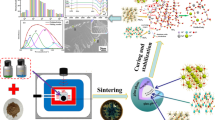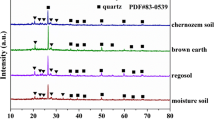The safe treatment of radionuclide-contaminated soil in uranium tailings is of critical importance. In this work, neodymium- and cerium-contaminated soil in uranium tailings were successfully immobilized via microwave sintering to form glasses with the addition of Na2CO3. The phase evolution and chemical durability of the as-prepared vitrified forms were systematically investigated using various spectroscopic and microscopic techniques. The results indicated that Nd and Ce could be fixed in glass structures, and the ultimate solid solubility of Nd and Ce reached 15 and 5 wt.%, respectively, with 20 wt.% Na2CO3 added. These samples were sintered at 1200°C for 40 min, and the solidified samples exhibited homogeneous elemental distribution. Moreover, the sintered matrices exhibited excellent chemical durability. The normalized leaching rates of Ce and Nd after 42 days were maintained at low values (~ 10 – 6 – 10–7 g ∙ m– 2 ∙ day–1).








Similar content being viewed by others
References
S. Chen, X. Shu, F. Luo, H. Dong, C. Xu, B. Li, D. Shao, and X. Lu, “Rapid vitrification of simulated Sr2+ radioactive contaminated soil for nuclear emergencies,” J. Radioanal. Nucl. Chem., 319, 115 – 121 (2019); https://doi.org/10.1007/s10967-018-6313-3.
J. Dragun, “Geochemistry and soil chemistry reactions occurring during in situ vitrification,” J. Hazard. Mater., 26, 343 – 364 (1991); https://doi.org/10.1016/0304-3894(91)85029-M.
H. Tang, Y. Li, W. Huang, S. Chen, and X. Lu, “Chemical behavior of uranium contaminated soil solidified by microwave sintering,” J. Radioanal. Nucl. Chem., 322, 2109 – 2117 (2019); https://doi.org/10.1007/s10967-019-06835-9.
S. Gin, P. Jollivet, M. Tribet, S. Peuget, and S. Schuller, “Radionuclides containment in nuclear glasses: an overview,” Radiochim. Acta, 105, 927 – 959 (2017); https://doi.org/10.1515/ract-2016-2658.
Guilin Wei, Minghe Shi, and Chen Xu, “Mechanical and leaching properties of neodymium-contaminated soil glass-ceramics,” J. Am. Ceram. Soc., 104(6), 2521 – 2529 (2021); https://doi.org/10.1111/jace.17713.
C. Prakash, S. Singh, A. Basak, G. Królczyk, A. Pramanik, L. Lamberti, and C. I. Pruncu, “Processing of Ti50Nb50–xHAx composites by rapid microwave sintering technique for biomedical applications,” J. Mater. Res. Technol., 9(1), 242 – 252 (2020).
M. Oghbaei and O. Mirzaee, “Microwave versus conventional sintering: A review of fundamentals, advantages and applications,” J. Alloys Compd., 494, 175 – 189 (2010); https://doi.org/10.1016/j.jallcom.2010.01.068.
S. Zhang, Y. Ding, X. Lu, X. Mao, and M. Song, “Rapid and efficient disposal of radioactive contaminated soil using microwave sintering method,” Mater. Lett., 175, 165 – 168 (2016); https://doi.org/10.1016/j.matlet.2016.04.018.
S. Zhang, X. Shu, S. Chen, H. Yang, C. Hou, X. Mao, F. Chi, M. Song, and X. Lu, “Rapid immobilization of simulated radioactive soil waste by microwave sintering,” J. Hazard. Mater., 337, 20 – 26 (2017); https://doi.org/10.1016/j.jhazmat.2017.05.003.
X. Shu, Y. Li, W. Huang, S. Chen, C. Xu, S. Zhang, B. Li, X. Wang, Q. Qing, and X. Lu, “Rapid vitrification of uraniumcontaminated soil: Effect and mechanism,” Environ. Pollut., 263 (2020); https://doi.org/10.1016/j.envpol.2020.114539.
X. Shu, S. Chen, W. Huang, B. Li, and X. Lu, “Immobilization of simulated An4+ in radioactive contaminated clay via microwave sintering,” Mater. Chem. Phys., 254, 123534 (2020); https://doi.org/10.1016/j.matchemphys.2020.123534.
G. Wen, K. Zhang, H. Zhang, Y. Teng, and Y. Zhou, “Immobilization and aqueous durability of Nd2O3 and CeO2 incorporation into rutile TiO2,” Ceram. Int., 41, 6869 – 6875 (2015);. https://doi.org/10.1016/j.ceramint.2015.01.137.
A. H. Naik, S. B. Deb, A. B. Chalke, et al. “Microwave-assisted low temperature synthesis of sodium zirconium phosphate (NZP) and the leachability of some selected fission products incorporated in its structure – A case study of leachability of cesium[ J],” J. Chem. Sci., 122(1), 71 – 82 (2010); https://doi.org/10.1007/s12039-010-0009-8.
ASTM C1285-14, Standard Test Methods for Determining Chemical Durability of Nuclear, Hazardous, and Mixed Waste Glasses and Multiphase Glass Ceramics: The Product Consistency Test (PCT), ASTM International, West Conshohocken, PA, 2014.
N. Raje, D. K. Ghonge, G. V. S. Hemantha Rao, and A. V. R. Reddy, “Impurity characterization of magnesium diuranate using simultaneous TG–DTA–FTIR measurements,” J. Nucl. Mater., 436, 40 – 46 (2013); https://doi.org/10.1016/j.jnucmat.2013.01.289.
John Adams, “Advances in the characterization of industrial minerals,” Elements, 6, 128 (2011).
K. Aasly, Properties and Behavior of Quartz for the Silicon Process, Thesis for the Degree of Philosophiae Doctor, Norwegian University of Science and Technology, Faculty of Engineering Science and Technology, Department of Geology and Mineral Resources Engineering (2008).
M. Karhu, J. Lagerbom, S. Solismaa, M. Honkanen, A. Ismailov, M.-L. Räisänen, E. Huttunen-Saarivirta, E. Levänen, and P. Kivikytö-Reponen, “Mining tailings as raw materials for reaction- sintered aluminosilicate ceramics: Effect of mineralogical composition on microstructure and properties,” Ceram. Int., 45, 4840 – 4848 (2019); https://doi.org/10.1016/j.ceramint.2018.11.180.
Y. Guo, Y. Li, F. Cheng, M. Wang, and X. Wang, “Role of additives in improved thermal activation of coal fly ash for alumina extraction,” Fuel Process. Technol., 110, 114 – 121 (2013); https://doi.org/10.1016/j.fuproc.2012.12.003.
X. Shu, Y. Li, W. Huang, S. Chen, C. Xu, S. Zhang, B. Li, Y. Wang, X. Wang, Q. Qing, and X. Lu, “Solubility of Nd3+ and Ce4+ in co-doped simulated radioactive contaminated soil after microwave vitrification,” Ceram. Int., 46, 6767 – 6773 (2020); https://doi.org/10.1016/j.ceramint.2019.11.167.
M. A. Vicente-Rodríguez, M. Suarez, M. Angel, and J. D. D. Lopez-Gonzalez, “Comparative FT-IR study of the removal of octahedral cations and structural modifications during acid treatment of several silicates,” Spectrochim. Acta. Part A. Molecular & Biomolecular Spectroscopy, 52, 1685 – 1694 (1996); https://doi.org/10.1016/S0584-8539(96)01771-0.
L. Y. Liang, Z. M. Liu, H. T. Cao, and X. Q. Pan, “Microstructural, optical, and electrical properties of SnO thin films prepared on quartz via a two-step method,” ACS Appl. Mater. Interfaces, 2, 1060 – 1065 (2010); https://doi.org/10.1021/am900838z.
L. Vidal, E. Joussein, M. Colas, J. Cornette, J. Sanz, I. Sobrados, J. L. Gelet, J. Absi, and S. Rossignol, “Controlling the reactivity of silicate solutions: A FTIR, Raman and NMR study,” Colloids Surf., A: Physicochem. Eng. Aspects, 503, 101 – 109 (2016); https://doi.org/10.1016/j.colsurfa.2016.05.039.
S. A. Macdonald, C. R. Schardt, D. J. Masiello, and J. H. Simmons, “Dispersion analysis of FTIR reflection measurements in silicate glasses,” J. Non-Cryst. Solids, 275, 72 – 82 (2000); https://doi.org/10.1016/S0022-3093(00)00121-6.
L. Truffault, M. T. Ta, T. Devers, K. Konstantinov, V. Harel, C. Simmonard, C. Andreazza, I. P. Nevirkovets, A. Pineau, and O. Veron, “Application of nanostructured Ca doped CeO2 for ultraviolet filtration,” Mater. Res. Bull., 45, 527 – 535 (2010); https://doi.org/10.1016/j.materresbull.2010.02.008.
H. Zhu, F. Wang, Q. Liao, et al. “Structure features, crystallization kinetics and water resistance of borosilicate glasses doped with CeO2[J],” J. Non-Cryst. Solids, 518, 57 – 65 (2019); https://doi.org/10.1016/j.jnoncrysol.2019.04.044.
Y. J. Li, J. X. Liu, and D. H. He, “Catalytic synthesis of glycerol carbonate from biomass-based glycerol and dimethyl carbonate over Li–La2O3 catalysts,” Appl. Catal., A, General, 564, 234 – 242 (2018); https://doi.org/10.1016/j.apcata.2018.07.032.
A. Wahid, A. M. Asiri, and M. M. Rahman, “One-step facile synthesis of Nd2O3/ZnO nanostructures for an efficient selective 2,4-dinitrophenol sensor probe,” Appl. Surf. Sci., 487, 1253 – 1261 (2019); https://doi.org/10.1016/j.apsusc.2019.05.107.
B. Glorieux, R. Berjoan, M. Matecki, A. Kammouni, and D. Perarnau, “XPS analyses of lanthanides phosphates,” Appl. Surf. Sci., 253, 3349 – 3359 (2007); https://doi.org/10.1016/j.apsusc.2006.07.027.
M. I. Ojovan and W. E. Lee, “Glassy wasteforms for nuclear waste immobilization,” Metall. Mater. Trans. A, 42, 837 – 851 (2011).
Acknowledgment
We thank Suzanne Adam, PhD, from Liwen Bianji, Edanz Editing China (www.liwenbianji.cn/ac), for editing the English text of a draft of this manuscript.
Funding
This work was supported by the Research and Development Program in key areas of Hunan Province (No. 2019SK2011), the Hunan Provincial Innovation Foundation for Postgraduates (No. CX20190711), the National Natural Science Foundation of China (No. 11875164), the National Defense Military Industry Project of China (No. JSZL2019403C001 and No. JSZL2017403B008), “The Thirteenth Five-Year Plan” Basic Technological Research Project (No. JSZL2018403B001), the Evaluation of Radioactive Effect of Soil Remediation in Mining and Metallurgy (No. JD201924), the Innovation Leading Plan of Hunan Province (No. 2020SK2024), and the Outstanding Youth Project of Hunan Province (No. 18B266).
Author information
Authors and Affiliations
Corresponding author
Additional information
Abstract published in Steklo i Keramika, No. 12, pp. 41 – 42, December, 2021.
Rights and permissions
About this article
Cite this article
Chen, M., Shi, K., Zhang, Q. et al. Rapid Vitrification of Uranium Tailings Via Microwave Sintering: Mechanism and Chemical Durability. Glass Ceram 78, 497–505 (2022). https://doi.org/10.1007/s10717-022-00440-1
Published:
Issue Date:
DOI: https://doi.org/10.1007/s10717-022-00440-1




